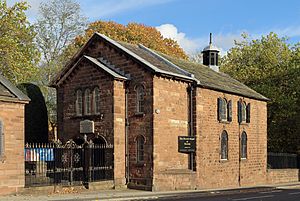Toxteth Unitarian Chapel facts for kids
Quick facts for kids Toxteth Unitarian Chapel |
|
|---|---|

View across Park Road
|
|
| Lua error in Module:Location_map at line 420: attempt to index field 'wikibase' (a nil value). | |
| OS grid reference | SJ 363 875 |
| Location | Dingle, Liverpool, Merseyside |
| Country | England |
| Denomination | Unitarian |
| History | |
| Founded | 1618 |
| Architecture | |
| Functional status | Active |
| Heritage designation | Grade I |
| Designated | 28 June 1952 |
| Architectural type | Chapel |
| Groundbreaking | 1618 |
| Completed | 1774 |
| Specifications | |
| Materials | Stone with slate roof |
Toxteth Unitarian Chapel is a special old building in Liverpool, England. It is located on Park Road in the Dingle area. Since the 1830s, many people have called it The Ancient Chapel of Toxteth. This chapel is very important, so it is listed as a Grade I building on the National Heritage List for England. This means it is one of the most important historic buildings in the country. It is still used today as a Unitarian chapel. Unitarians are a group of Christians who believe in one God and focus on reason and individual freedom of belief. The chapel is part of the General Assembly of Unitarian and Free Christian Churches, which supports Unitarian churches in Britain.
History of the Chapel
Early Beginnings and Puritan Farmers
The story of the chapel began in 1611. At that time, a group of Puritan farmers built a school in Toxteth. Puritans were a group of Protestants who wanted to make the Church of England simpler. They chose a 15-year-old named Richard Mather to be the school's teacher.
Richard Mather and Nonconformist Preaching
Richard Mather later went to Brasenose College, Oxford to continue his studies. However, he was asked to return to Toxteth. By then, the chapel had been built. On November 30, 1618, he gave his first sermon there. He later became a minister in the Church of England. But Richard Mather was a Nonconformist. This meant he did not agree with all the rules of the Church of England. Because of his preaching, he was stopped from being a minister in 1633 and again in 1634. In 1635, he moved to America.
Changes and Growth of the Chapel
By 1662, the chapel's minister was a Presbyterian named Thomas Crompton. Presbyterians are another group of Protestants. He was joined by another Dissenter, Michael Briscoe. Dissenters were people who disagreed with the Church of England. In 1672, both ministers received special permission to preach. The chapel was made larger to welcome Dissenters from central Liverpool.
Neglect, Rebuilding, and Unitarianism
Over time, more chapels were built in other areas. Because of this, the Toxteth chapel was not used as much and started to fall apart. In 1774, it was partly rebuilt. Around this time, most of the people who attended the chapel became Unitarian. The other members left to form a new group. In 1841, a porch was added to the chapel. Today, Unitarian services are still held at the chapel every two weeks.
What the Chapel Looks Like
Outside the Chapel
The chapel is built from stone and has a roof made of slate. It has two floors. There is also a part that sticks out on the west side. The windows are rounded at the top and have stone frames. At the west end, there are two rounded entrances side-by-side. Above them, you can see a special plaque and three windows. On the south side, there is a small, eight-sided tower called a cupola. It has openings called louvres and a decorative top piece called a finial.
Inside the Chapel
Inside, the pulpit (where the minister preaches) is at the east end. There are seating areas called galleries on three sides. The chapel also has special seats called box pews throughout. The galleries on the north and south sides are very old, from the 1600s. The gallery that connects them was added in the 1700s. Two of the box pews have dates carved into them: 1650 and 1700. You can also see memorial plaques inside, including a brass one from 1656 and others from the 1700s and early 1800s.
Graveyard and Organ
Outside the chapel, there is a graveyard. It has a mid-1800s classical arcade, which is a row of arches. The chapel's organ was built in 1906 by a company called Brindley & Foster.
Jeremiah Horrocks Memorial
The chapel has a special memorial plaque for Jeremiah Horrocks. He was an astronomer who lived in the 1600s. Horrocks was the first person to correctly predict when the planet Venus would pass in front of the Sun. He was also a member of this chapel.
See also
- Grade I listed buildings in Liverpool
- Grade I listed churches in Merseyside
- Ullet Road Unitarian Church
Images for kids



